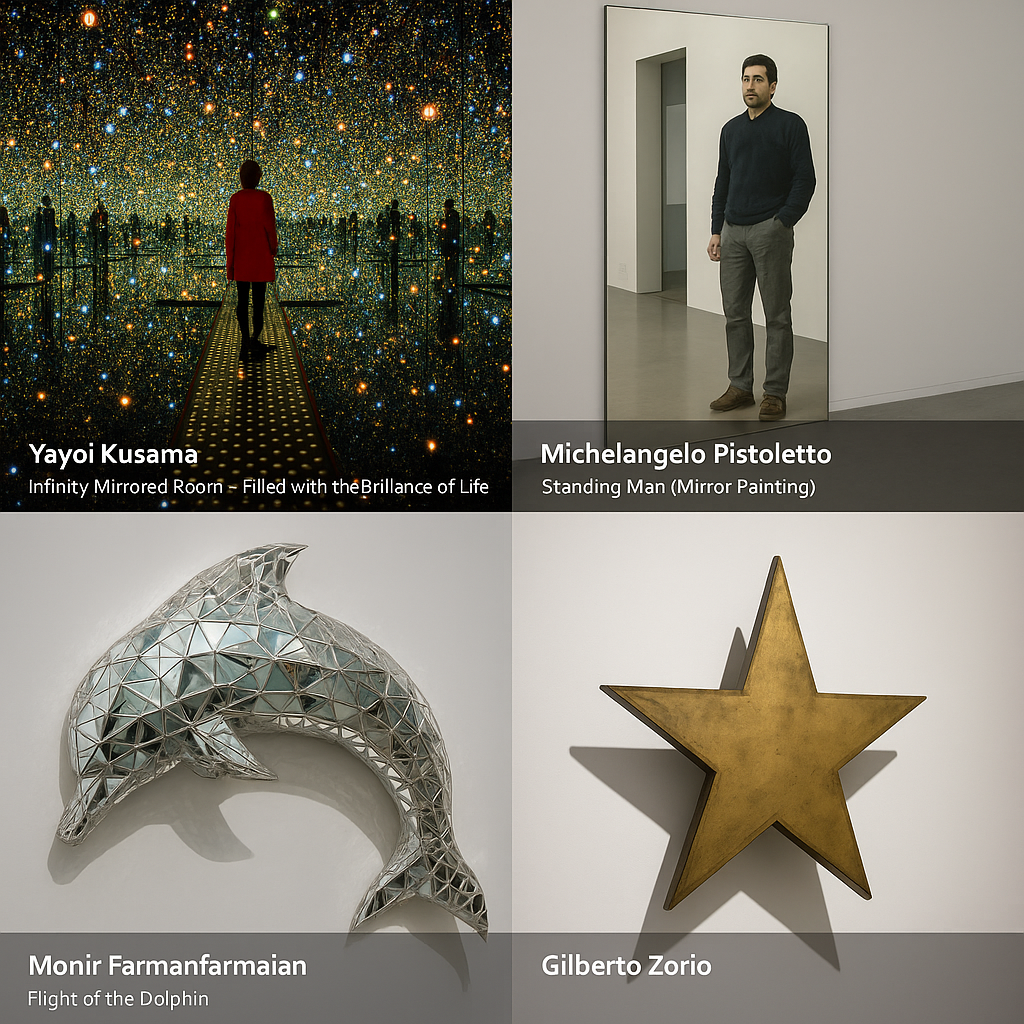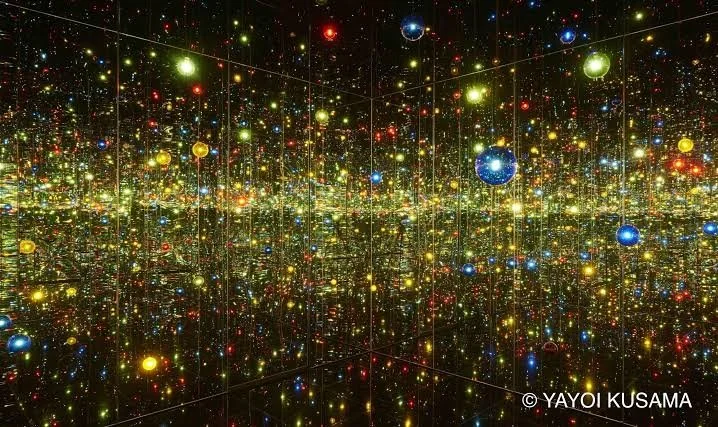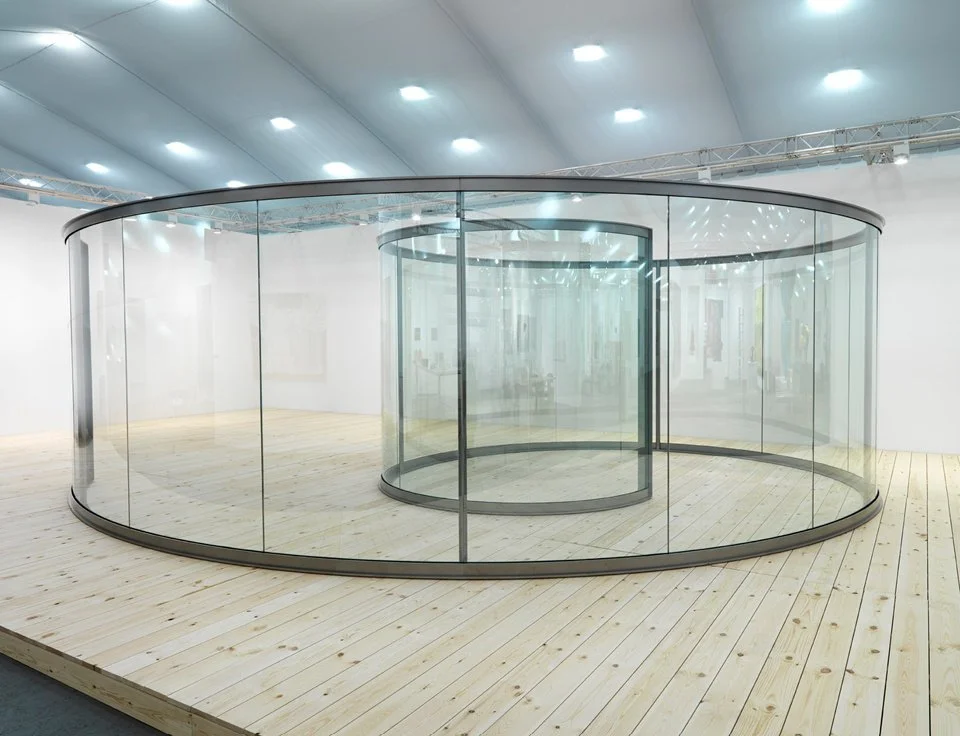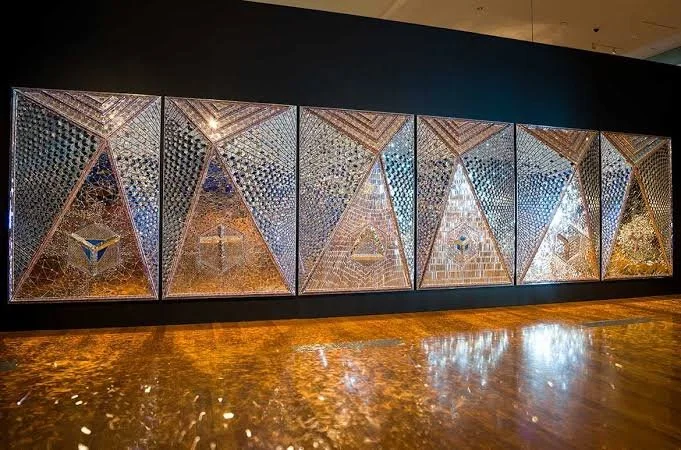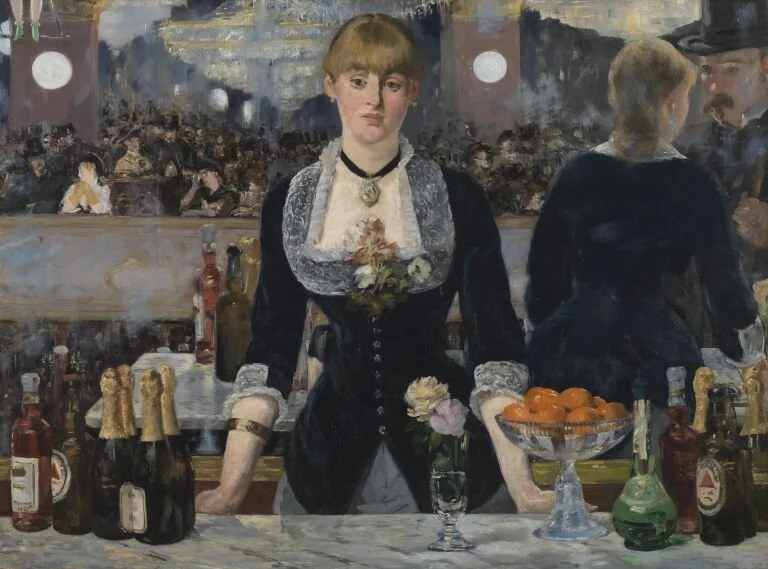The Mirror Field: Mirror & Shadow Work for Self-Discovery and Alchemy
The Ache of Being Seen but Not Met
In the rush of modern life, many of us give until we are empty. We perform productivity, polish our identities, and present curated outcomes to the world—yet inside, there is a quiet ache. The ache of being seen, but not truly met.
This ache is not weakness. It is the whisper of your perception asking to return home. It is the body reminding you that self-discovery cannot come from constant giving alone. To feel whole, we must balance the rhythm of giving and receiving, of action and rest, of being witnessed and witnessing ourselves.
This is where Mirror Shadow Work enters as a profound practice of art therapy, spirituality, and alchemy. The mirror does not only show our appearance—it reflects our hidden perceptions, our disowned shadows, and our unspoken truths. When combined with creative practices, breathwork, and sacred geometry, the mirror becomes a portal to self-discovery.
The Mirror Field, an 8-week creative circle by Active Kreative, is not a workshop in the conventional sense. It is a space where performance rests, and perception returns. Here, mirrors are not surfaces; they are thresholds. Here, shadow work becomes not frightening but fertile—an alchemical path of remembering who you are.
Why this, why now?
Because many of us learned to show the frame and hide the mirror. We learned to display polish, outcomes, performance—while concealing the trembling truth that gives art its soul and life its meaning. The ache you feel when your work is “seen” but you are not? That ache is sacred. It tells you your perception was not met, not rejected but unmet, like a song sung to ears that couldn’t hear. The dissatisfaction is not failure; it’s a compass. It says: this wasn’t the right field—yet.
The Mirror Field calls in a different kind of witness. Not spectators. Witnesses. People who come not to admire but to awaken—first themselves, then each other. In this field, your attention is medicine. Your breath is a metronome for the soul. Your hands become translators for what words cannot say. And together, we remember what the world asked us to forget: there is a truth inside you that doesn’t need permission to exist.
Mirrors in Art – From 19th Century to Today
For centuries, artists have turned to mirrors to question identity, perception, and truth.
Édouard Manet’s A Bar at the Folies-Bergère (1882) famously destabilises the viewer. The barmaid looks out with detached eyes, while the mirror behind her reflects a distorted perspective. Nothing aligns perfectly, suggesting that perception is never straightforward. This painting is less about what we see, and more about how fragile “seeing” is.
The Pre-Raphaelite painters often depicted women before mirrors, not as vanity, but as explorations of inner life. Mirrors became metaphors for duality—the outer image versus the inner truth.
In contemporary art, Yayoi Kusama’s Infinity Mirror Rooms surround visitors with endless reflections, dissolving the boundary between self and world. Step inside, and you are multiplied into infinity, a living question about who you are.
Michelangelo Pistoletto’s Mirror Paintings invite the viewer to complete the work. Stand before them, and your own reflection merges with the art. Suddenly, life itself is the canvas.
Monir Shahroudy Farmanfarmaian, blending Persian mirror mosaic with modern abstraction, created radiant geometries that fragment and recombine. Her work reveals how broken pieces can become luminous again—an exquisite metaphor for shadow work and healing.
In each case, the mirror is never neutral. It asks: What is true here? Who is really being seen?
Philosophy & Psychology – Mirrors of the Mind
Philosophers and psychologists, too, have long turned to mirrors to explore the self.
Plato, in his Allegory of the Cave, reminds us that we mistake shadows for reality until we learn to turn and face the light. The mirror in art therapy is this turning—a way of meeting what is true beyond surface appearances.
Jacques Lacan described the mirror stage of infancy, when the child recognises their reflection. This moment forms the ego, both empowering and alienating: we see ourselves, but as an image, not the fullness of being. Mirror work allows us to move beyond image, into essence.
Carl Jung wrote of the Shadow: “Everyone carries a shadow, and the less it is embodied in the individual’s conscious life, the blacker and denser it is.” Mirror work is a way of meeting this shadow gently, reclaiming disowned parts of the self.
Marcel Proust offered: “The real voyage of discovery consists not in seeking new landscapes, but in having new eyes.” Mirror shadow work gives us exactly that: new eyes for the life we already live.
These insights are not abstract philosophy—they are maps. They tell us that the mirror is never about reflection alone. It is about perception, identity, and transformation.
Mirrors in Spirituality & Witchcraft
Across cultures, mirrors have been seen as portals, tools, or protective symbols.
In Buddhist philosophy, the awakened mind is called the “mirror mind”—clear, reflective, unobstructed.
In shamanic and pagan traditions, mirrors were used in ritual to glimpse beyond the ordinary.
The Elizabethan mystic John Dee used a black obsidian mirror for scrying, seeking visions and counsel from the unseen. His mirror still sits in the British Museum, a reminder that mirrors have long been regarded as gateways.
In European folklore, mirrors were covered during mourning to protect the soul’s passage, or used under moonlight for divination.
In modern witchcraft, the black mirror is used in ritual as a surface for projection. It does not “foretell” the future—it reveals the subconscious. In The Mirror Field, we honour these traditions respectfully, using the mirror not as fortune-telling but as contemplative art therapy: a way to meet what is hidden, soften perception, and invite integration.
The Simulation Metaphor – Life as a Mirror
Some philosophers, like Nick Bostrom, have suggested that we may be living in a simulation—a reality programmed by higher beings or future humans. Whether literal or not, the metaphor is potent.
Life often behaves like a mirror. We do not see “things as they are”; we see projections of our own beliefs, wounds, and nervous system patterns. Change the inner code, and the outer world reflects differently.
In this way, the mirror becomes not only a tool of art therapy, but a cosmic reminder: you are always in conversation with your own perception.
The Alchemical Arc – Nigredo to Rubedo
Alchemy, the ancient science of transformation, describes four key stages:
Nigredo (Blackening): Meeting shadow, composting performance.
Albedo (Whitening): Clarifying perception, rinsing away distortion.
Citrinitas (Yellowing): Re-composing fragments into pattern.
Rubedo (Reddening): Integration, embodiment, vow.
The Mirror Field follows this arc. Each week is a portal, moving from reflection → dissolution → recomposition → integration. It is less about learning something new, and more about remembering what was hidden.
🌒✨ The Alchemical Path of Transformation ✨🌘
In my circles, we work inside what I call The Mirror Field—a living process where art, reflection, and presence reveal who we truly are. This journey isn’t random—it follows the ancient alchemical stages of transformation, also echoed in Jungian psychology.
🜏 Nigredo – The Blackening
We begin in the dark. Shadow rises, masks crack, projections dissolve. Jung called this confronting the unconscious. In the Mirror Field, this is where we meet what we’ve hidden—through clay, masks, and raw expression.
🜍 Albedo – The Whitening
Here comes clarity. After the breakdown, a soft light enters. Old stories rinse away. In Jungian terms, this is purification—the stripping back of illusions. In practice, we write, breathe, and remember the child within.
🜚 Citrinitas – The Yellowing
This stage is powerful—and often painful. Edward Edinger described it as the moment we realize the other is not our projection, but a separate soul. The light of truth hurts, but it awakens consciousness. In Mirror Field, this is silent witnessing, seeing with new eyes.
❤️ Rubedo – The Reddening
At last, integration. The opposites unite, spirit and matter embrace. James Hillman wrote that here, lovers no longer see each other as gods, but as souls. In our circles, this becomes celebration, collage, and embodied presence.
🌹 Applied Jungian Psychology teaches us that transference, countertransference, anima, and animus are all part of this dance. Each stage dismantles projection and opens the way for true recognition—of self, of other, of soul.
Why It Works (body → nervous system → breath → mind → remembrance)
We keep it beautifully simple—and somatically precise. Our approach integrates art therapy, polyvagal-informed regulation, breathwork, visualisation, and sacred geometry so change is felt, not just understood.
The Body: Orient, ground, and move
Gentle bilateral actions (hand tracing, soft tapping, wrist circles) cue safety.
Slow mark-making lowers performance pressure and turns attention inward.
Result: body says “I’m safe enough to see,” which is step one for shadow work and mirror work.
The Nervous System: Co-regulate, then create
We use predictable rhythms (timed shares, repeatable drawing sequences) to quiet hyper- or hypo-arousal.
The group’s witnessing offers relational safety: seen, not solved.
Result: a ventral vagal state where connection and curiosity return—ideal for art therapy for energy balance.
The Breath: Bridge between body and mind
Simple patterns (box breath 4-4-4-4, 4-7-8, or phi-paced exhale) anchor presence.
On exhale we emphasise giving; on inhale, receiving—retraining the left/right energetic rhythm (left side feminine energy, right side masculine energy).
Result: a felt balance between giving and receiving that you can reproduce at home.
The Image: Language of the subconscious
Sacred geometry (Circle, Vesica, Seed of Life, Star Tetrahedron) gives the mind a clean structure while the psyche speaks through colour and symbol.
Collage & mask-making allow disowned parts to appear safely, then rejoin the whole.
Result: insight without overwhelm; meaning self-assembles (Citrinitas).
The Word & Vow: Integration
Short journaling prompts convert image into language without analysis paralysis.
The closing vow line (Rubedo) turns knowing into direction.
Result: remembrance—not a new self, but the self you stopped abandoning.
Louise Hay’s Mirror Work
Louise Hay’s Mirror Work is a transformative self-help practice that empowers individuals to cultivate self-love, heal emotional wounds, and shift their internal dialogue. Developed by the late Louise L. Hay, bestselling author of You Can Heal Your Life, mirror work is a foundational tool in the world of self-healing and affirmations. At its core, mirror work involves looking into a mirror—directly into your own eyes—and speaking positive affirmations aloud. Though it may sound simple, this process can uncover deep emotional layers and initiate profound personal transformation.
How Mirror Work Heals from the Inside Out
Mirror work is based on the belief that the way we speak to ourselves internally shapes our emotional, mental, and even physical well-being. Louise Hay believed that many of our struggles—whether they manifest as anxiety, self-doubt, illness, or relationship issues—stem from a lack of self-love and unresolved negative beliefs. Mirror work aims to confront these patterns by bringing them to the surface, then consciously shifting them through consistent, loving affirmations.
When you begin this practice, you might feel resistance, discomfort, or even sadness. That’s completely normal. The mirror reflects not just your physical image, but your deepest thoughts and emotions. As you continue to show up for yourself, speak kindly, and witness your own healing journey, this discomfort often turns into compassion, acceptance, and empowerment.
Mirror Work and the Law of Attraction
Mirror work is also closely tied to the Law of Attraction. According to this principle, what we think and believe, we attract. If you believe you are unworthy or unloved, your experiences may mirror those beliefs. But by consistently affirming love, worth, and abundance while looking in the mirror, you begin to align your inner world with the external reality you desire. In this way, mirror work becomes a powerful tool for manifesting positive change in your life.
Why Art Therapy + Mirror Work Heals?
The Active Kreative Methodology blends expressive arts, somatic practices, breath, and sacred geometry. Why does this work?
Whole-brain activation: Art-making engages the intuitive right hemisphere and the structured left, balancing perception.
Polyvagal-informed nervous system regulation: Breath and gentle movement activate parasympathetic states of safety and calm.
Symbolic processing: Colours, masks, and collages let us express truths beyond words—vital for shadow integration.
Sacred geometry: Drawing circles, vesicas, and stars recalls the body’s innate coherence. Geometry steadies the mind so the shadow can emerge safely.
Embodied integration: Closing rituals with vows ensure insight does not stay abstract—it becomes lived.
Learn more on our Active Kreative Methodology page.
Join the Field
If you’ve ever felt the hum beneath the surface—that whisper that there is more to you than what you show—the Mirror Field is calling.
This is not homework. This is homecoming.
🌿 Explore Workshops
🌿 Book a private 1:1 Art Therapy session
🌿 Join us for Events & Retreats
Step into the Mirror Field. Remember yourself.
FAQs – Mirror & Shadow Work in The Mirror Field
-
Not at all. If you can draw a circle or cut paper, you are ready. The focus is process, not product.
-
No. This is therapeutic-arts, grounded in art therapy principles but not clinical psychotherapy. If you need clinical care, referrals are available.
-
Mirror shadow work is the practice of using reflection—literal and symbolic—to meet disowned parts of yourself, integrate shadow, and restore balance between giving and receiving.
-
Because mirrors reveal both light and shadow. They help us notice projections, reclaim perception, and embody presence.
-
In practice, the right hand (masculine, giving) releases what you carry; the left hand (feminine, receiving) welcomes nourishment. This retrains the nervous system’s natural reciprocity.
-
Yes—when practiced with consent and pacing. You can always pass, adapt, or pause. We combine mirror gaze with grounding, geometry, and breathwork.
Closing Passage – When the Mirror Answers Back
At the end of The Mirror Field, you stand with your finished mask. You place it on, then remove it. You meet your gaze in the mirror, and for the first time in a long time, you feel no need to perform. You draw a star and write a vow: “I remember. I am here.”
This is not an exhibition. This is not performance.
It is a mirror.
Not of me—of you.
✨ The transmission wants to complete. Let the right witnesses gather. Let the field open.

